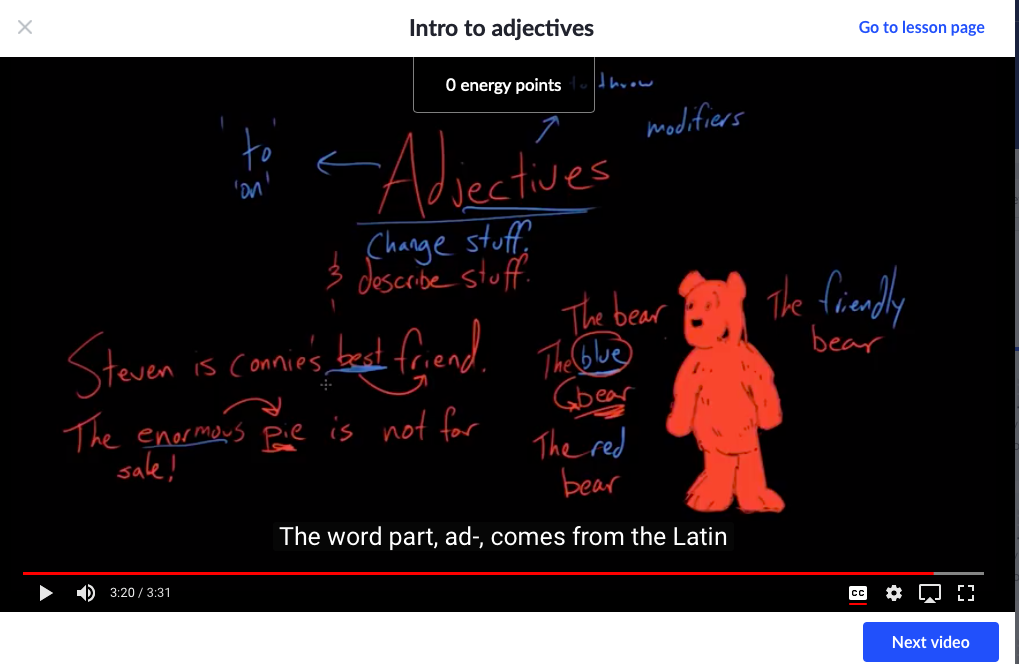I decided to take a closer look at Khan Academy, since under Arts and Humanities there is a Grammar course with six units, one of them on adjectives, the topic I chose for my blended course. I found the site quite easy to navigate and the lessons engaging.

The content covered in the unit entitled “The modifier” is well developed and detailed with clear explanation. The unit includes lessons on articles, adjectives and adverbs. As an English as an Additional Language (EAL) teacher, I would probably structure the unit a little differently, teaching the skills in smaller steps. Teaching the articles, adjectives and adverbs separately, before I compare and contrast adjectives and adverbs would help avoid any possible confusion. Pre-teaching might be necessary since I found the lessons be at a higher level. I would probably add more modules focusing on adjectives, their synonyms and antonyms, to help my students build vocabulary skills in order to express themselves easily.
The unit itself consists of engaging lessons representing the content through text, sound, still pictures and moving images. The text of the lessons is short and to the point. I particularly liked the teaching method chosen, giving the sensation of looking at a board, just like in a classroom. This is very helpful especially if we are teaching EAL students, since the learner can follow the lesson a lot easier when they hear it and see the information written down. This is a great tool to develop reading and listening skills at the same time. I also think that neat printing is crucial especially when teaching students who are new to the language. Incorporating typed up text can help avoid misunderstanding. The drawings and interesting stories make it easier for students to understand and remember the content covered, enabling them to use both eyes and ears in conjunction (Bates). The use of two different colours when explaining also helps in directing the listeners’ attention. The fact that the learners have the ability to stop and start the recorded audio, it enables them to master content, improve pronunciation, and listening skills. It also supports students with low literacy skills.

I liked that Khan Academy made the lessons more effective by including subtitles and transcript to every lesson. I think the auto-translate option is fantastic for the students with limited English level of proficiency, having the option to translate the subtitles for a better understanding. Listening to the Hungarian and Romanian translations, I found the accuracy level quite high. The added transcript makes the lessons accessible even to people with hearing disability.
The style of the lessons was quite catchy. I also found the length of the lessons very appropriate, ranging between 2-7 minutes, depending on the content covered. Every mini lesson is followed by a practice exercise where students can apply what they have comprehended. With the help of immediate feedback, students can easily reach mastery. The 16-20 minutes long unit test at the end assesses the ten skills covered by the unit. The detailed skill report provides the teacher with an accurate picture of the students’ understanding that is useful in order to support the students in the areas they are facing difficulties. The assessment is lacking in composed textual response though.
Although I found the modules effective and enjoyable, I think EAL students would benefit from short videos as well, that have a richer medium providing the opportunity to link the use of modifiers to our everyday lives. On the other hand, according to Bates, creating an audio clip has its advantages, requiring far less bandwidths than video, making the downloads quicker, and can be combined with text.
I think that Khan Academy’s freely available units can be very helpful for teachers who lack experience and/or time to develop high quality educational videos. The lessons can be posted directly into Google Classroom, Facebook, Twitter, and Email. There is also the option for teachers to create their own classroom of 24 students, with a ready to download parent permission form for students under 13. Unfortunately, the letter of permission is translated only into 9 languages. Having EAL families with limited English it would be beneficial to have the option to auto-translate the letter in various languages.
